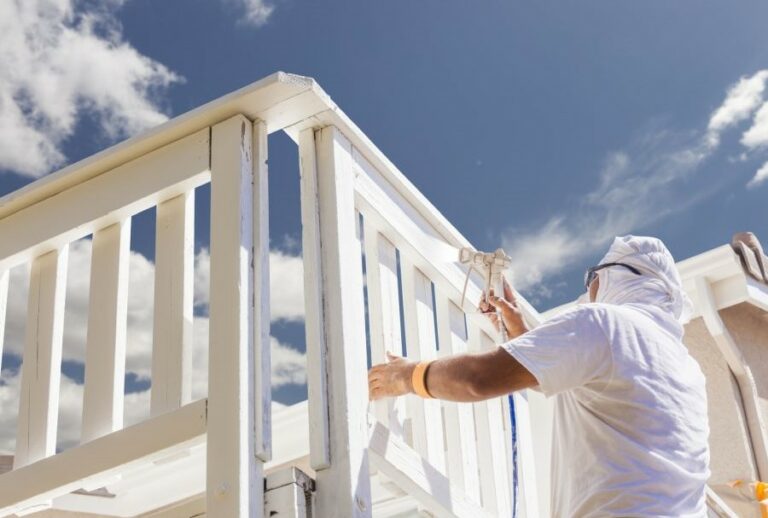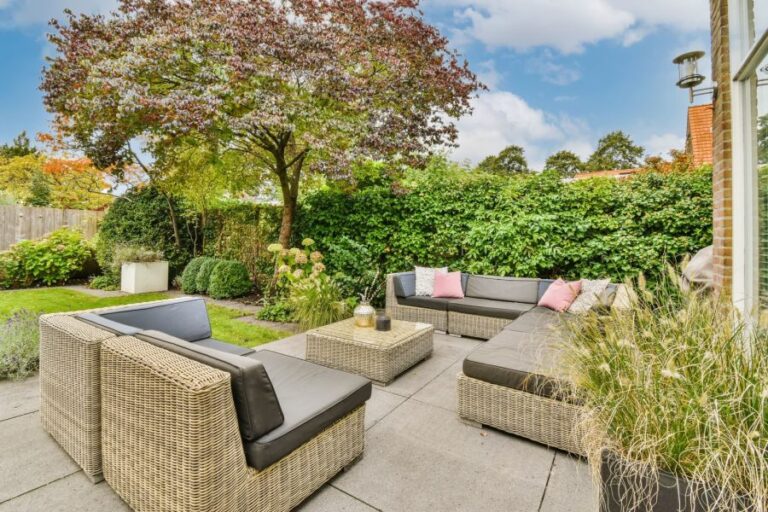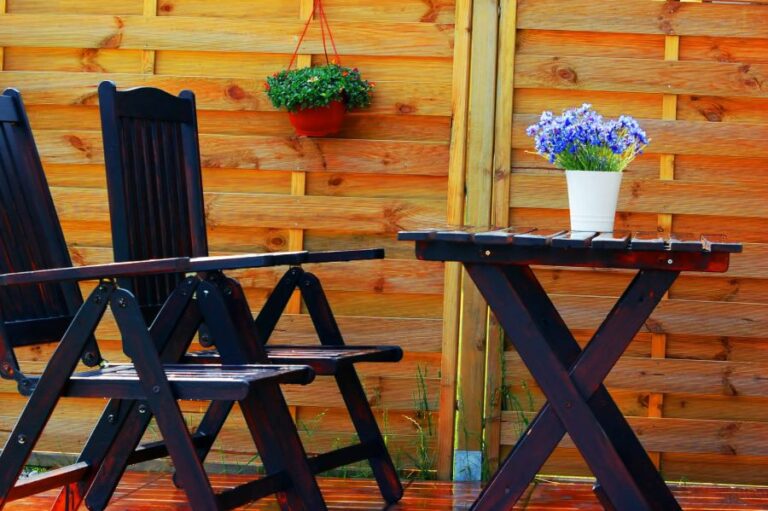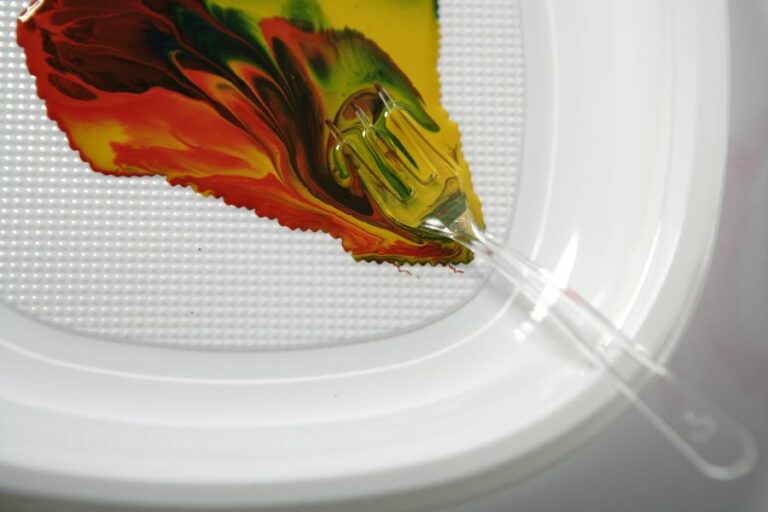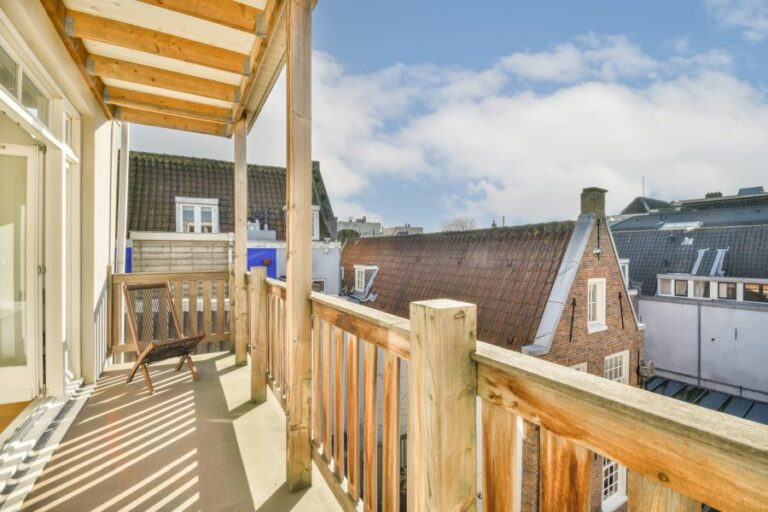Outdoor Concrete Floor Paint Colors, 25 Things You Should Know
Transform your outdoor living space with a fresh coat of paint! Let’s explore an array of stunning concrete floor paint colors, perfect for upgrading your patio, deck, or pool area. Discover how to make an impact by incorporating vibrant hues or adding a touch of elegance with subtle shades. Unlock the potential of your outdoor oasis through this comprehensive guide, packed with essential tips for choosing the perfect color for your concrete floor painting project.
Outdoor concrete floor paint colors:
Concrete is versatile for outdoor floors such as patios, walkways, and pool decks. However, plain concrete can be dull, making paint colors crucial in enhancing the appearance of outdoor spaces. There’s a variety of solid colors like greys, earth tones, and bold colors, or specialty finishes like terrazzo, epoxy flake, and stamped concrete available. When choosing colors, consider the existing color scheme, climate, maintenance, and the size of the area. Properly prepare the surface, prime, apply paint, and seal for a beautiful and functional outdoor floor.

Discover endless possibilities with outdoor concrete floor paint colors! Dive into this comprehensive guide on choosing and applying the perfect hue for your space while learning about durability, trends, and budget-friendly options for a stunning transformation. Happy painting!
Contents
- 1 Exterior Concrete Floor Paint Color Options
- 2 Which Color is Most Suitable for an Outdoor Concrete Floor?
- 3 What is the Most Suitable Color for Painting Concrete Floors?
- 4 Which Type of Paint is Suitable for an Outdoor Concrete Floor?
- 5 What color should be used to paint a concrete porch floor?
Exterior Concrete Floor Paint Color Options
Concrete is a versatile and durable building material widely used for constructing outdoor floors, including patios, walkways, and pool decks. However, plain concrete can be somewhat dull, and you might want to add some color and style to enhance the appearance of your outdoor spaces.
You can make your outdoor concrete floors more attractive and appealing with the right paint colors.
• Types of Outdoor Concrete Floor Paint Colors
– Solid Colors
Solid colors are popular for concrete floor paints because they create a clean, uniform look. Most solid color paints are available in a variety of shades, from light neutrals to bold, bright hues. Some popular solid color options for outdoor concrete floors include:
- Greys: Available in a range of shades, from light to dark. Grey works well as a neutral base for other colors and design elements in your outdoor spaces.
- Earth Tones: These warm colors, such as tans, beiges, and browns, can complement the natural surroundings and create a more natural, organic look for your outdoor floors.
- Bold Colors: If you want your outdoor floor to make a statement, consider using a bold color like red, blue, or green. These colors can create a strong visual impact and can be tempered with other design elements, such as furniture or plantings, to maintain balance in the overall design.
– Multicolor and Specialty Finishes
Multicolor and specialty finishes can create unique, eye-catching effects on your outdoor concrete floors. Some popular options include:
- Terrazzo: This finish mimics the look of traditional terrazzo flooring, which consists of small, colorful chips of marble or other materials embedded in a concrete base. Terrazzo paint finishes feature small, randomly dispersed flecks of color, giving your floors a more interesting and textured appearance.
- Epoxy Flake: This paint finish combines colored flakes, usually in a complementary palette, with a clear epoxy topcoat. The result is a durable, slip-resistant surface with an attractive, speckled appearance.
- Stamped Concrete: Stamped concrete involves imprinting patterns or textures onto the concrete floor’s surface before the paint is applied. This can create the appearance of natural stone, brick, or other materials and can be further enhanced with color to create a realistic and stylish outdoor floor.
• Factors to Consider When Choosing Outdoor Concrete Floor Paint Colors
- Existing Color Scheme: Consider the colors of your home’s exterior, landscaping, and other outdoor design elements. Choosing a paint color complements the overall color scheme is important.
- Climate: In hotter climates, lighter colors tend to be more practical as they reflect heat, while darker colors absorb it. Likewise, lighter colors may show dirt more easily in dusty or muddy environments.
- Maintenance: Some paint colors and finishes may require more frequent or specialized maintenance. Make sure you’re aware of the maintenance requirements before making your selection.
- Size of Area: Light colors can make a small space appear larger, while dark colors can create a more intimate atmosphere.
• How to Paint Your Outdoor Concrete Floor
- Prepare the Surface: Start by cleaning your concrete floor thoroughly to remove any dirt, debris, or grease using a pressure washer or floor scrubber. For heavily stained, pitted, or rough concrete, consider using a concrete resurfacer or patching compound to create a smooth, even surface.
- Prime: After the concrete is clean and dry, apply a coat of concrete primer with a paint roller or brush, following the manufacturer’s instructions. The primer helps ensure proper adhesion of the paint and can improve the durability of the finished surface.
- Apply Paint: Once the primer is dry, use a roller, brush, or paint sprayer to apply the chosen paint color. For solid colors, expect to apply at least two coats, allowing the first coat to dry completely before applying the second. Follow the manufacturer’s instructions for specialty finishes to achieve the desired appearance.
- Seal: To protect and prolong the life of your painted concrete floor, apply a clear concrete sealer after the paint is completely dry. This will help protect the surface from moisture, stains, and general wear and tear.
• Personal Recommendations
- Test before committing: Test paint color samples on a small, inconspicuous area of your concrete floor before painting the entire surface to make sure the color and finish meet your expectations.
- Consider existing textures and features: Remember the characteristics of your outdoor floor, such as the texture and any decorative elements, when choosing a paint color or finish.
- Match your style: Your choice of paint color should reflect your personal style and the overall design aesthetic of your outdoor space. Don’t be afraid to get creative with color combinations and specialty finishes.
In conclusion, outdoor concrete floor paint colors play a crucial role in enhancing the appearance of your outdoor spaces.
By understanding the different types of paint colors and finishes, taking into account key factors, and following a proper painting process, you can create beautiful and functional outdoor floors that complement your home and landscape design.
Which Color is Most Suitable for an Outdoor Concrete Floor?
When it comes to outdoor concrete flooring, choosing the right color can be a daunting task. With an array of shades and tints available, it is essential to select a color that will look good and withstand changing climate conditions and high foot traffic.
• Factors to Consider When Choosing Color for Outdoor Concrete Floor
– Climate
The climate in your region plays a significant role in determining the most suitable color for an outdoor concrete floor. In hotter regions, consider opting for lighter shades as they help reflect heat and maintain a cooler surface temperature.
On the other hand, darker shades are suitable for colder regions because they absorb and retain heat more effectively.
– Aesthetics
The visual appeal of your outdoor concrete floor should also be a determining factor when choosing the color. The chosen shade should ideally complement your overall exterior design, including your home’s facade, landscaping, and any outdoor furniture or fixtures.
– Maintenance
Maintenance is always a crucial part of deciding on the color of your outdoor concrete floor. Although ideal for volatile temperatures, lighter shades tend to reveal stains and dirt more visibly.
In contrast, darker colors can sometimes hide more impurities but are not as effective in maintaining cool temperatures.
– Durability
Lastly, consider the durability of the color. Since outdoor concrete floors are exposed to different weather conditions, ensure that the color you choose is capable of withstanding wear and tear over time. Look for products that offer UV resistance to prevent fading due to sun exposure.
• Top Color Choices for Outdoor Concrete Floors
Here are some popular color choices for outdoor concrete floors, considering the factors mentioned above:
– Earth Tones
Earth tones are always a safe option for outdoor concrete floors, as they blend well with most exteriors and natural landscapes. Moreover, earth tones are known for being low-maintenance and more durable compared to other shades. Some of the best earth-tone colors include:
- Sandstone
- Terracotta
- Dark brown
- Beige
- Taupe
– Cool Grays
Cool grays are an excellent option for modern and minimalist outdoor spaces. These colors offer a sleek and clean appearance while being versatile enough to complement different exterior design styles.
Additionally, cool gray shades work great in hot climates due to their heat-reflective properties. Some popular choices include:
- Light gray
- Charcoal gray
- Slate gray
- Silver
– Warm Tones
For warmer regions with a lot of greenery, warm tones like gold, amber, or terra cotta can be attractive. These colors help in enhancing the natural beauty of your outdoor space and can create a cozy and inviting atmosphere. Some of the best warm-toned colors for outdoor concrete floors include:
- Amber
- Terra cotta
- Warm gold
- Copper
– Contrasting Shades
If you want something unique and striking, opt for contrasting shades that create visual interest and generate a bold statement. For example, a black or dark gray outdoor concrete floor can be stunning against a light-colored exterior.
However, keep in mind that this option may not be suitable for very hot climates, as darker shades tend to retain heat.
• Conclusion
In conclusion, selecting the best color for your outdoor concrete floor boils down to personal preferences and factors such as climate, aesthetics, maintenance, and durability.
It is essential to consider all these factors and weigh their importance based on your needs and the specific requirements of your outdoor space. Earth tones, cool grays, warm tones, and contrasting shades are all excellent color options that cater to different styles and requirements.
So, take your time to explore the available choices, and you’ll be sure to find the perfect color that enhances your outdoor space’s aesthetics and provides functionality and long-lasting durability.
Type of Concrete | Color | Description |
|---|---|---|
Stamped Concrete | Earth tones | Shades of brown, beige, and tan are suitable for stamped concrete floors, providing an attractive and natural look. |
Polished Concrete | Gray | A polished gray floor offers a simple, classic appearance that is both durable and visually appealing. |
Stained Concrete | Custom colors | With stained concrete, the color can be customized to suit your preferences or mimic the appearance of natural stone. |
Pervious Concrete | Light colors | For previous concrete floors, lighter shades are advised to prevent heat absorption and encourage the evaporation of surface water. |
Colored Concrete | Dark colors | Dark shades, such as black, dark gray, or dark brown, can provide added UV protection while camouflaging dirt and stains. |
What is the Most Suitable Color for Painting Concrete Floors?
Concrete floors are becoming increasingly popular among homeowners and business owners alike due to their durability, affordability, and versatility. A key aspect of customizing a concrete floor to suit your personal style and needs is choosing the right color.
• Things to Consider When Choosing a Color
– Purpose of the Space
The space’s primary function should inform the color choice for your concrete floor. High-traffic areas, such as garages or warehouses, will require more durable and dirt-resistant colors, whereas a living room or retail space may warrant a more aesthetically pleasing hue.
– Lighting Conditions
The available lighting in the area can also impact your choice of color. Natural light will make colors appear lighter and brighter, so choosing a color that will not be too harsh or overwhelming in well-lit spaces is essential.
Conversely, darker colors can make dimly lit areas appear even darker, so opt for a lighter shade if the space has limited lighting.
– Existing Decor and Style
It’s crucial to consider the surrounding area’s existing style, color scheme, and decor when selecting a color for your concrete floor. The color should seamlessly blend into the space’s overall design without clashing or overpowering the other elements.
• Popular Color Options for Concrete Floors
– Neutral Colors
Neutral colors, such as beige, tan, and gray, are versatile and timeless, making them the most popular choice for concrete floor color. These hues are ideal for high-traffic areas, as they hide dirt and stains well.
They also make it easier for homeowners and business owners to change decor and furniture without needing to repaint the floor. Neutral colors work well in both residential and commercial settings, as they tend to be calming and soothing to the eyes.
– Earth Tones
Earth tones, including various shades of brown, green, and terracotta, are ideal for creating a warm and inviting atmosphere. These colors work particularly well in outdoor spaces, such as patios and walkways, as they blend well with natural surroundings.
Additionally, they are often used in rustic or Mediterranean-inspired interiors
– Bold Colors
For those looking to make a statement, bold colors like red, blue, or yellow can add a vibrant and dynamic touch to a space. However, it is essential to exercise caution when using such hues, as they can quickly become overwhelming or clash with other elements in the room.
Bold colors are best reserved for accent pieces or smaller areas, such as concrete countertops or decorative inlays.
– Custom Colors
Custom color options can be created for a truly personalized touch by mixing various pigments and stains. Some concrete floors can even be designed to mimic the look of natural stone or wood, offering endless design possibilities.
However, custom color options may come at a higher cost compared to pre-made color selections.
• Recommended Paint Types for Concrete Floors
– Epoxy
Epoxy coatings are highly recommended for their durability and resistance to stains, chemicals, and abrasions. They are suitable for garages, warehouses, and other industrial settings, providing long-lasting protection for concrete floors.
Epoxy coatings can be tinted to match your desired color and combined with decorative elements like metallic flakes or colored quartz.
– Water-Based Stains
Water-based stains are excellent for achieving a more opaque and consistent color across the concrete floor. These stains are typically more eco-friendly, low in odor, and quick-drying, making them popular among homeowners.
Water-based stains can be found in a wide variety of colors, including those that mimic the look of natural stone or wood.
– Acid Stains
Consider using acid stains on your concrete floor for a more unique and variegated color effect. Acid stains react chemically with the concrete itself, resulting in a one-of-a-kind and organic-looking color variation. Acid-stained floors can be sealed with a clear topcoat for added durability and protection.
• Final Thoughts
Choosing the best color for your concrete floor comes down to the specific needs, style, and overall design of the space in question. In general, neutral and earth-toned colors are the most popular and versatile choices, while bold or custom colors can be used for a more distinctive look.
Regardless of the hue, make sure to use suitable paint types for added protection and longevity of your concrete floors.
| What is the best color to paint concrete floors? | |
|---|---|
| 1 | Gray |
| 2 | Beige or Tan |
| 3 | White |
| 4 | Dark Blue |
| 5 | Green |
Which Type of Paint is Suitable for an Outdoor Concrete Floor?
Outdoor concrete floors are a common feature in many homes and commercial spaces. They offer durability, and versatility, and can be customized to suit individual preferences. To maintain and improve the appearance of your outdoor concrete floor, you need to use the right type of paint.
• Types of Paint for Outdoor Concrete Floor
There are four main types of paint suitable for outdoor concrete floors: epoxy paints, acrylic latex paints, concrete stains, and urethane-based paints.
– Epoxy Paints
Epoxy paints are a popular choice for outdoor concrete floors because of their durability, resistance to chemicals, and ability to withstand heavy foot traffic. These two-component paints create a strong bond with the concrete surface, forming a protective layer that is resistant to UV rays, water, and staining.
Pros
- High durability and chemical resistance
- Available in a variety of colors and finishes
- Withstands heavy foot traffic
- Easy maintenance
Cons
- Requires careful surface preparation
- Can be slippery when wet
- May not be suitable for areas exposed to direct sunlight
– Acrylic Latex Paints
Acrylic latex paints are another suitable option for outdoor concrete floors. Water-based paints offer good adhesion and flexibility, allowing them to expand and contract with the concrete surface. This prevents the paint from cracking or peeling off due to fluctuating temperatures and moisture levels.
Pros
- Good adhesion and flexibility
- Available in various colors and finishes
- Easy to apply and clean up
- Resist mildew and UV rays
Cons
- May require multiple coats for proper coverage
- Not as durable as epoxy paints
– Concrete Stains
Concrete stains are a unique option that can enhance the natural appearance of your outdoor concrete floor.
They penetrate the surface of the concrete, creating a permanent color that won’t fade over time. Stains come in water- and acid-based varieties, each giving a distinct look to the concrete surface.
Pros
- Provides a natural and unique look
- Long-lasting color that won’t fade or peel
- Resistant to UV rays, water, and staining
- Can be used with other concrete treatments
Cons
- Limited color options compared to paints
- Requires proper surface preparation and application techniques
– Urethane-Based Paints
Urethane-based paints are a more durable alternative to acrylic latex paints. These paints offer excellent adhesion and resistance to chemicals, making them suitable for heavy-traffic areas like garages and driveways.
Urethane paints also provide a glossy finish that is resistant to UV rays and weather conditions.
Pros
- Strong adhesion and chemical resistance
- Provides a glossy, protective finish
- Resistant to UV rays and weather conditions
Cons
- May require priming before application
- Difficult to clean up due to its solvent-based nature
- Limited color options
• Factors to Consider When Choosing Paint for Outdoor Concrete Floors
When selecting the right paint for your outdoor concrete floor, consider the following factors:
– Durability and Resistance
Choose a durable paint resistant to chemicals, abrasions, and weather conditions. Epoxy and urethane-based paints are known for their durability and resistance, making them suitable for heavy-traffic areas and outdoor environments.
– Surface Preparation Requirements
Different types of paint require varying degrees of surface preparation before application. Epoxy paints and concrete stains typically require more extensive preparation, including cleaning, etching, and priming. Ensure that you are willing to invest the time and effort required for proper surface preparation.
– Appearance and Finish
Consider the desired appearance and finish of your outdoor concrete floor. Concrete stains might be your best option if you prefer a natural look. If you want a glossy, protective finish, urethane-based paints might be more suitable.
– Ease of Application and Maintenance
Some paints are easier to apply and maintain than others. Acrylic latex paints are typically the easiest to apply and clean up, while epoxy and urethane-based paints might require more effort. Choose a paint that aligns with your level of experience and preference for maintenance.
• Conclusion
When it comes to choosing the right paint for your outdoor concrete floor, there are several options to consider. Each type of paint has its pros and cons, and the best choice depends on your individual needs, preferences, and the specific conditions of your outdoor concrete floor.
By considering factors such as durability, resistance, surface preparation, appearance, and ease of application, you can select the paint that will best enhance and protect your outdoor concrete flooring for years to come.
What color should be used to paint a concrete porch floor?
I will discuss the essential factors in choosing the right color for your concrete porch floor, including aesthetics, durability, and practical considerations to achieve the perfect balance between form and function.
• Why Paint Matters for Concrete Porch Floors
– Improved Aesthetics
Painting your concrete porch floor is an excellent way to enhance its visual appeal. With a fresh coat of the right paint, your porch can become a more inviting and visually pleasing space. The right color can create a welcoming ambiance while also accentuating the architectural features of your home’s exterior.
– Protective Coating
Painting your porch floor also offers functional benefits to ensure its longevity. The layer of paint acts as a protective barrier, shielding the concrete from weather elements such as rain, snow, sunlight, and temperature shifts.
This protection helps prevent cracks, chipping, and staining, keeping your porch in pristine condition for years to come.
– Easier Maintenance
Maintaining a concrete porch floor can be time-consuming and challenging due to its porous nature. Painted concrete surfaces are significantly easier to clean, as the paint seals the pores, preventing dirt and stains from penetrating the material.
This simplifies the maintenance process and helps keep your porch looking immaculate.
• Factors to Consider When Choosing a Color
Before you can decide on the perfect paint color for your concrete porch floor, consider the following factors:
– Home Exterior Color Palette
One of the primary considerations when choosing a porch floor color should be the existing color scheme of your home’s exterior. The paint color should complement and enhance your home’s aesthetics and create a harmonious visual flow.
Opting for a color that either contrasts or coordinates well with your siding, trim, and other exterior elements is advisable.
– Climate and Sun Exposure
The climate and amount of sun exposure your porch receives can play a crucial role in determining the most suitable porch floor color. Dark colors tend to absorb more heat and can become uncomfortably hot under the sun, while lighter shades remain cooler in sunny areas.
Conversely, a darker color can make the space feel warmer if your porch is situated in the shade.
– Porch Size and Space
The size and layout of your porch space can also influence the choice of paint color. Lighter colors can help create the illusion of a more spacious and open area in smaller or enclosed porches. On the other hand, choosing a darker shade can create a cozy ambiance in more extensive or open porch spaces.
– Existing Features and Elements
Ensure that your chosen porch floor color complements or highlights exterior accents, such as architectural details, furniture, planters, railings, and lighting fixtures. The color should seamlessly blend with these elements, contributing to the overall visual harmony of the space.
• Popular Paint Colors for Concrete Porch Floors
While personal preference and taste play a significant role in selecting the ideal paint color, the following recommendations can serve as inspiration for your concrete porch floor:
– Greige
Greige, a blend of gray and beige, offers a neutral yet inviting appearance for your porch floor. It has a classic tone that works well with various home styles and outdoor decor. Greige can be a wonderful middle ground between traditional beige and more modern gray paint shades.
– Light Gray
Light gray is a popular choice that provides a clean, sophisticated look for contemporary and traditional homes alike. It complements most exterior home colors and is also an excellent choice for masking dirt, dust, and wear.
– Slate Blue
Slate blue is a unique and versatile color for porch floors, working well with various shades of gray, blue, and white in home exteriors. It adds a touch of color while still maintaining a soothing and relaxed atmosphere for your outdoor space.
– Soft Green
A soft, muted green shade can be ideal for porches surrounded by lush greenery. It helps connect your porch with the natural environment, creating a serene and peaceful ambiance.
– Dark Charcoal
Dark charcoal porch floors give your outdoor space a sense of drama and sophistication. This bold option can provide an excellent contrast with lighter home exterior colors and effectively hide dirt and wear.
• Final Thoughts
In conclusion, the color of your concrete porch floor significantly impacts your outdoor space’s overall aesthetic appeal, practicality, and longevity.
By carefully considering factors such as your home’s exterior color palette, climate, porch size and layout, and existing features, you can select a paint color that complements your home’s design and ensures durability and easy maintenance.

